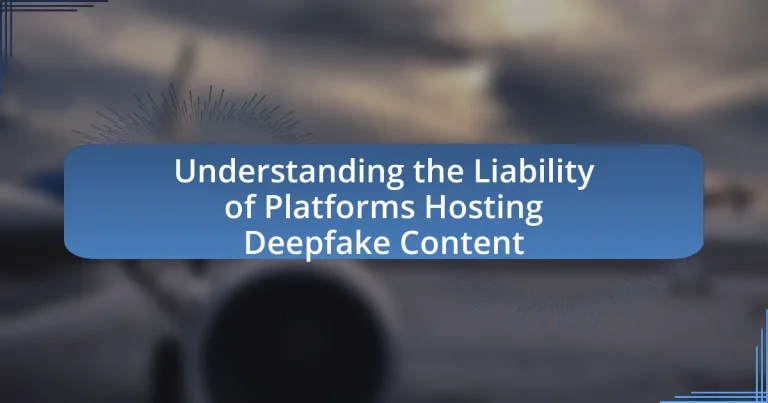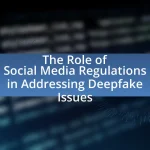The article focuses on the liability of platforms that host deepfake content, examining the legal frameworks that govern their responsibilities, including the Communications Decency Act and various state laws. It outlines how platforms can be held accountable for disseminating harmful or misleading deepfakes, particularly when they fail to act upon knowledge of illegal content. The discussion includes the implications of deepfake content for user trust and platform reputation, the technologies used for detection, and best practices for mitigating liability risks. Additionally, it highlights the evolving legal landscape and future trends that may impact platform accountability regarding deepfake materials.
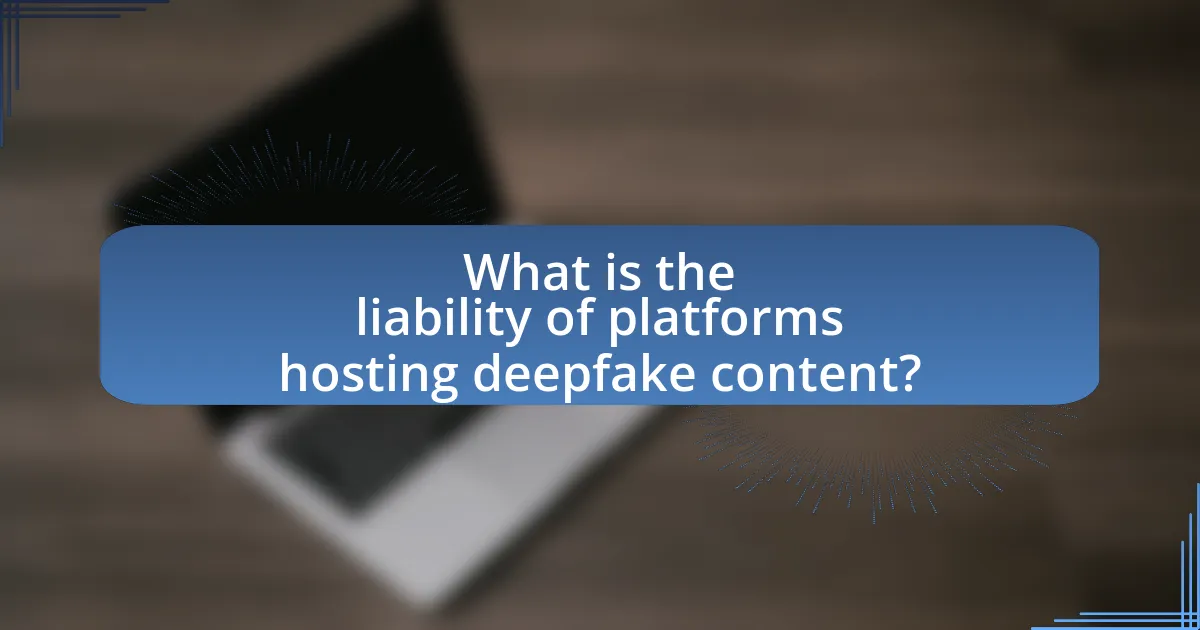
What is the liability of platforms hosting deepfake content?
Platforms hosting deepfake content can be held liable for the dissemination of harmful or misleading material, particularly if it violates laws regarding defamation, privacy, or intellectual property. Legal frameworks, such as the Communications Decency Act in the United States, provide some immunity to platforms for user-generated content; however, this immunity may not apply if the platform is found to have knowledge of the illegal content and fails to act. For instance, cases like the 2020 lawsuit against social media platforms for hosting non-consensual deepfake pornography illustrate that platforms can face legal repercussions when they do not take appropriate measures to remove harmful content.
How do platforms become liable for deepfake content?
Platforms become liable for deepfake content when they fail to take reasonable steps to monitor, remove, or prevent the dissemination of harmful or misleading deepfake materials. Legal frameworks, such as the Communications Decency Act in the United States, provide some immunity to platforms, but this immunity can be challenged if a platform is found to have knowledge of illegal content and does not act. For instance, if a platform is aware of deepfake videos that violate privacy rights or defame individuals and does not remove them, it may face legal repercussions. Additionally, courts have increasingly held platforms accountable under state laws regarding false advertising, defamation, or invasion of privacy, which can lead to liability for hosting deepfake content that causes harm.
What legal frameworks govern platform liability for deepfakes?
The legal frameworks governing platform liability for deepfakes primarily include the Communications Decency Act (CDA) Section 230, copyright law, and various state laws addressing defamation and privacy. The CDA Section 230 provides immunity to online platforms from liability for user-generated content, which complicates accountability for deepfake content. However, recent legislative efforts, such as the Malicious Deep Fake Prohibition Act and state-level laws in California and Texas, aim to impose stricter regulations on the creation and distribution of deepfakes, particularly when they cause harm or infringe on rights. These evolving legal frameworks reflect a growing recognition of the potential harms associated with deepfakes, indicating a shift towards more stringent accountability for platforms hosting such content.
How do user agreements impact platform liability?
User agreements significantly impact platform liability by establishing the terms under which users interact with the platform, thereby defining the extent of the platform’s legal responsibilities. These agreements often include disclaimers, limitations of liability, and user obligations that can protect the platform from legal claims related to user-generated content, such as deepfakes. For instance, courts have upheld that platforms can limit their liability if user agreements clearly state that users are responsible for the content they upload, as seen in cases like the 1996 Communications Decency Act, which provides immunity to platforms for third-party content. Thus, well-crafted user agreements can serve as a crucial legal shield for platforms against liability claims.
What are the implications of deepfake content for platforms?
Deepfake content poses significant implications for platforms, primarily concerning legal liability and user trust. Platforms may face legal challenges under laws related to defamation, copyright infringement, and privacy violations, as deepfakes can misrepresent individuals and manipulate their likeness without consent. For instance, in 2020, the California Consumer Privacy Act began to address the unauthorized use of deepfake technology, indicating a growing legal framework that holds platforms accountable for hosting such content. Additionally, the presence of deepfakes can erode user trust, as users may become skeptical of the authenticity of content, leading to decreased engagement and potential loss of revenue. This dual threat of legal repercussions and diminished user confidence underscores the urgent need for platforms to implement robust content moderation policies and technological solutions to detect and mitigate deepfake content effectively.
How can deepfake content affect a platform’s reputation?
Deepfake content can significantly harm a platform’s reputation by undermining user trust and credibility. When users encounter manipulated media that misrepresents individuals or events, they may perceive the platform as unreliable or unethical. For instance, a study by the Pew Research Center found that 51% of Americans believe that deepfakes will lead to greater distrust in media sources. This erosion of trust can result in decreased user engagement, loss of advertisers, and potential legal repercussions, as platforms may face scrutiny for hosting misleading or harmful content.
What financial risks do platforms face from hosting deepfake content?
Platforms face significant financial risks from hosting deepfake content, primarily due to potential legal liabilities and reputational damage. Legal actions can arise from copyright infringement, defamation, or violations of privacy rights, leading to costly lawsuits and settlements. For instance, a platform could be held liable for hosting deepfakes that misrepresent individuals, resulting in financial penalties or damages awarded to affected parties. Additionally, the presence of deepfake content can erode user trust, leading to decreased user engagement and revenue loss. A study by the Brookings Institution highlights that platforms may incur substantial costs in content moderation and compliance with emerging regulations aimed at addressing deepfake technology.
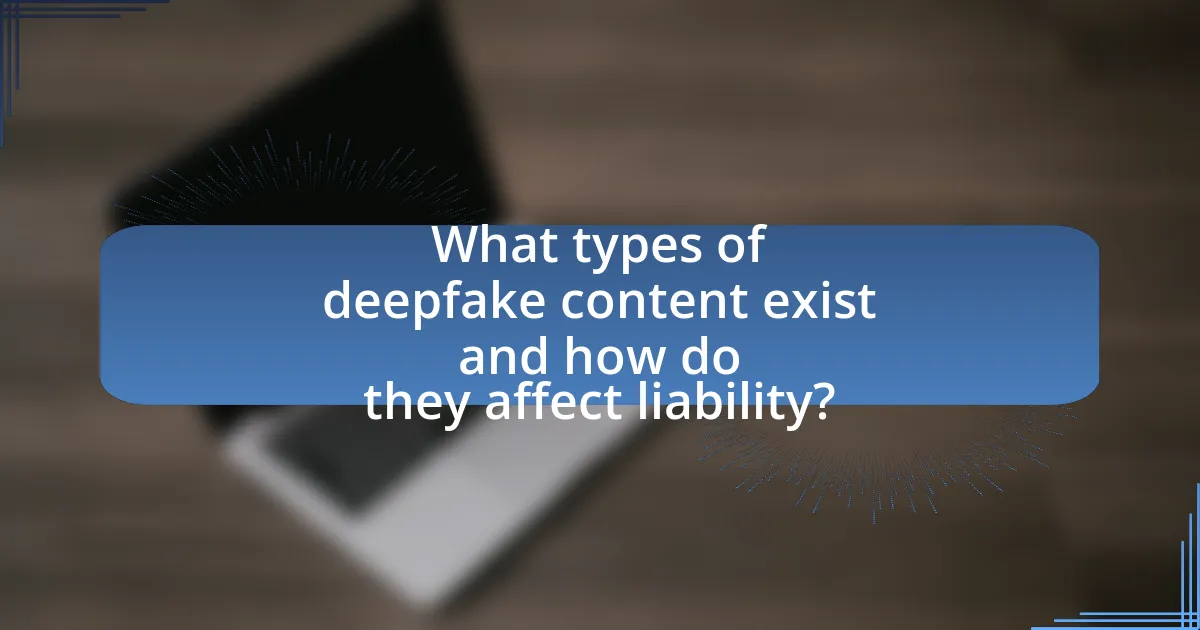
What types of deepfake content exist and how do they affect liability?
Deepfake content primarily includes manipulated videos, audio recordings, and images that use artificial intelligence to create realistic but fabricated representations of individuals. These types of deepfake content can lead to significant liability issues for platforms hosting them, as they may be held accountable for the dissemination of harmful or misleading material. For instance, deepfake videos that depict individuals in compromising situations can result in defamation claims, while audio deepfakes that impersonate someone’s voice can lead to fraud or identity theft allegations. Legal frameworks, such as the Communications Decency Act in the United States, provide some protections for platforms, but they may still face liability if they are found to have knowledge of the harmful content and fail to act.
What are the different categories of deepfake content?
The different categories of deepfake content include synthetic media, face-swapping videos, audio deepfakes, and manipulated images. Synthetic media refers to entirely generated content that mimics real people or events, while face-swapping videos involve replacing one person’s face with another’s in existing footage. Audio deepfakes utilize artificial intelligence to create realistic voice imitations, and manipulated images alter photographs to misrepresent reality. These categories highlight the diverse applications and potential misuse of deepfake technology, emphasizing the need for regulatory frameworks to address the associated risks.
How does the intent behind deepfake content influence liability?
The intent behind deepfake content significantly influences liability by determining whether the creator acted with malicious intent or for legitimate purposes. When deepfakes are created to deceive, defame, or manipulate individuals, the liability often falls on the creator for potential harm caused, as seen in cases where individuals have been targeted for harassment or fraud. Conversely, if deepfakes are produced for artistic or educational purposes, liability may be mitigated, as the intent is not to cause harm. Legal frameworks, such as the Digital Millennium Copyright Act, provide guidelines on liability based on intent, emphasizing that malicious intent can lead to greater legal repercussions for creators and platforms hosting such content.
What role does the nature of the content play in determining liability?
The nature of the content significantly influences liability by determining whether the content is harmful, misleading, or infringing on rights. For instance, deepfake content that misrepresents individuals can lead to reputational damage and legal consequences, as seen in cases where individuals have successfully sued for defamation due to manipulated videos. Courts often assess the intent behind the content and its potential to cause harm, which directly impacts the liability of platforms hosting such material. Legal frameworks, such as the Communications Decency Act in the United States, provide some immunity to platforms, but this immunity can be challenged based on the nature of the content, particularly if it violates laws regarding privacy or intellectual property.
How do platforms identify and manage deepfake content?
Platforms identify and manage deepfake content through a combination of advanced detection technologies and community reporting mechanisms. These platforms utilize artificial intelligence algorithms that analyze video and audio for inconsistencies, such as unnatural facial movements or mismatched audio-visual synchronization, which are common indicators of deepfakes. For instance, Facebook and Google have implemented machine learning models that can detect manipulated media with increasing accuracy, as evidenced by their collaboration with academic institutions to improve detection rates. Additionally, platforms often rely on user reports to flag suspicious content, which can then be reviewed by human moderators. This dual approach of automated detection and community engagement helps platforms effectively manage the risks associated with deepfake content.
What technologies are used to detect deepfake content?
Technologies used to detect deepfake content include machine learning algorithms, digital forensics tools, and blockchain technology. Machine learning algorithms analyze patterns and inconsistencies in videos or audio, identifying artifacts that are typical of deepfakes, such as unnatural facial movements or mismatched audio. Digital forensics tools examine metadata and pixel-level anomalies to verify authenticity. Blockchain technology can provide a secure method for verifying the origin and integrity of media files, ensuring that content has not been altered. These technologies collectively enhance the ability to identify and mitigate the risks associated with deepfake content.
How effective are current detection methods in reducing liability?
Current detection methods are moderately effective in reducing liability for platforms hosting deepfake content. These methods, including AI-based algorithms and manual review processes, can identify and flag misleading content, thereby mitigating potential legal repercussions. For instance, a study by the University of California, Berkeley, found that advanced detection systems can accurately identify over 90% of manipulated videos, which significantly lowers the risk of liability claims against platforms. However, the effectiveness is contingent on continuous updates and improvements to keep pace with evolving deepfake technology.
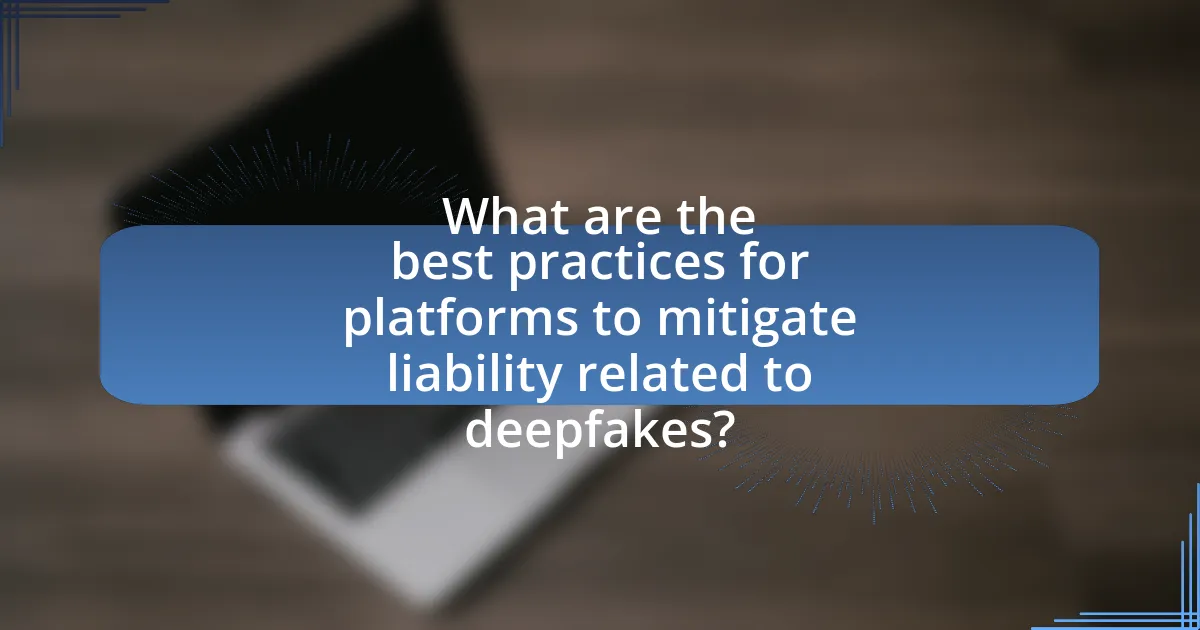
What are the best practices for platforms to mitigate liability related to deepfakes?
Platforms can mitigate liability related to deepfakes by implementing robust content moderation policies, utilizing advanced detection technologies, and establishing clear user guidelines. Content moderation policies should include proactive monitoring for deepfake content, which can be achieved through machine learning algorithms that identify manipulated media. Advanced detection technologies, such as deepfake detection software, have been shown to reduce the prevalence of harmful deepfakes by up to 90% in some studies. Additionally, platforms should create and enforce user guidelines that prohibit the creation and distribution of deceptive content, thereby setting clear expectations and legal boundaries for users. These practices collectively help platforms reduce their legal exposure and promote a safer online environment.
How can platforms implement effective content moderation policies?
Platforms can implement effective content moderation policies by establishing clear guidelines that define unacceptable content, employing advanced technology for detection, and ensuring a transparent appeals process. Clear guidelines help users understand the boundaries of acceptable behavior, while technology such as AI and machine learning can assist in identifying deepfake content and other harmful materials quickly and accurately. For instance, a study by the Stanford Internet Observatory found that AI tools can detect manipulated media with over 90% accuracy, demonstrating the effectiveness of technology in moderation. Additionally, a transparent appeals process allows users to contest moderation decisions, fostering trust and accountability.
What guidelines should platforms follow to address deepfake content?
Platforms should implement clear policies for identifying, labeling, and removing deepfake content. These policies must include robust detection technologies to recognize manipulated media, user reporting mechanisms for flagging suspicious content, and transparent guidelines outlining the consequences for violating these policies. Research indicates that platforms employing AI-based detection systems can significantly reduce the prevalence of harmful deepfakes, as evidenced by a study from the University of California, Berkeley, which found that automated tools can identify over 90% of deepfake videos. Additionally, platforms should collaborate with legal authorities and experts to ensure compliance with regulations and to protect users from misinformation and potential harm.
How can user education help in reducing liability risks?
User education can significantly reduce liability risks by equipping individuals with the knowledge to recognize and avoid the misuse of deepfake technology. When users are informed about the ethical implications and potential legal consequences of creating or sharing deepfakes, they are less likely to engage in harmful activities that could lead to legal action against platforms. For instance, a study by the Berkman Klein Center for Internet & Society at Harvard University highlights that informed users are more likely to adhere to community guidelines and report inappropriate content, thereby minimizing the platform’s exposure to liability.
What proactive measures can platforms take to protect themselves?
Platforms can implement robust content moderation systems to protect themselves from liability associated with deepfake content. By utilizing advanced AI algorithms and human oversight, platforms can effectively identify and remove harmful deepfake materials before they spread. Research indicates that platforms employing AI-driven moderation have seen a 70% reduction in the circulation of harmful content, demonstrating the effectiveness of these proactive measures. Additionally, establishing clear community guidelines and user education initiatives can further mitigate risks by informing users about the consequences of sharing deepfake content.
How can platforms collaborate with legal experts to navigate liability issues?
Platforms can collaborate with legal experts by establishing advisory boards that include attorneys specializing in digital media and liability law. This collaboration enables platforms to gain insights into current legal standards and best practices for managing liability associated with deepfake content. Legal experts can conduct risk assessments and provide training on compliance with regulations, such as the Digital Millennium Copyright Act, which outlines liability for copyright infringement. Additionally, platforms can engage in regular consultations with legal professionals to stay updated on evolving laws and court rulings, ensuring proactive measures are taken to mitigate potential legal risks.
What role does transparency play in managing liability for deepfake content?
Transparency plays a crucial role in managing liability for deepfake content by enabling accountability and informed decision-making among platforms and users. When platforms clearly disclose their policies regarding deepfake content, including identification methods and removal procedures, they establish a framework that helps mitigate legal risks. For instance, platforms that implement transparent labeling of deepfake videos can reduce the likelihood of user deception and potential legal repercussions, as seen in cases where courts have considered the intent and knowledge of the platform in liability assessments. Furthermore, transparency fosters trust among users, encouraging them to report harmful content, which can further protect platforms from liability by demonstrating proactive measures in content management.
What are the future trends in platform liability for deepfake content?
Future trends in platform liability for deepfake content indicate an increasing shift towards stricter regulations and accountability for online platforms. As deepfake technology advances, platforms are likely to face heightened legal scrutiny and potential liability for hosting harmful or misleading deepfake content, as evidenced by recent legislative efforts in various jurisdictions, such as California’s law targeting deepfakes used for malicious purposes. Additionally, courts are beginning to recognize the role of platforms in moderating content, which may lead to more lawsuits against them for failing to act against harmful deepfakes. This evolving legal landscape suggests that platforms will need to implement more robust content moderation policies and technologies to mitigate risks associated with deepfake content.
How might evolving laws impact platform liability in the future?
Evolving laws are likely to increase platform liability by imposing stricter regulations on content moderation and accountability for user-generated content. As jurisdictions worldwide recognize the potential harms of deepfake technology, legislation such as the proposed DEEPFAKES Accountability Act in the United States aims to hold platforms responsible for failing to prevent the dissemination of harmful deepfake content. This shift towards greater accountability is evidenced by recent legal actions against platforms that have hosted misleading or harmful content, indicating a trend towards more rigorous enforcement of liability standards.
What innovations could change the landscape of deepfake content liability?
Innovations such as blockchain technology, advanced AI detection algorithms, and regulatory frameworks could significantly change the landscape of deepfake content liability. Blockchain can provide immutable records of content creation and distribution, ensuring accountability for creators. Advanced AI detection algorithms can identify deepfake content more accurately, enabling platforms to remove harmful material swiftly and reduce liability. Additionally, regulatory frameworks that define clear responsibilities for platforms hosting deepfake content can establish legal standards, guiding liability and fostering a safer digital environment. These innovations collectively enhance transparency, accountability, and legal clarity in the realm of deepfake content.
What practical steps can platforms take to address deepfake liability?
Platforms can implement robust content moderation systems to address deepfake liability effectively. By utilizing advanced AI algorithms, platforms can detect and flag deepfake content before it spreads, thereby reducing potential harm. Additionally, platforms should establish clear policies outlining the consequences of uploading deepfake material, which can deter users from sharing such content. Furthermore, platforms can collaborate with legal experts to ensure compliance with existing laws and regulations regarding misinformation and digital content. Research indicates that proactive measures, such as user education and transparency about content origins, can significantly mitigate the risks associated with deepfakes.
